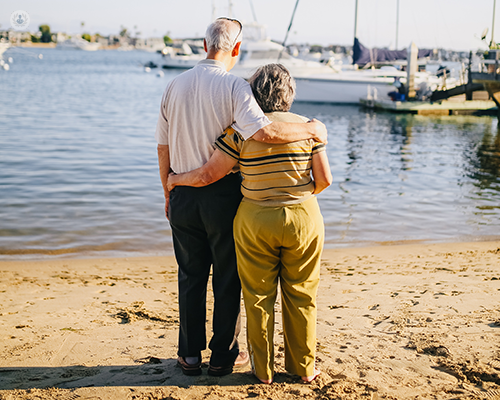Osteoporosis explained: fractures, diagnosis, and bone-building drugs
Written by:Osteoporosis, one of the most common metabolic bone mineral conditions, affects more than three million people in the UK. Dr Rod Hughes, a highly esteemed rheumatologist, provides a comprehensive guide to the condition, explaining risk factors, diagnosis, prevention, and treatment.

What is osteoporosis, and how do I know that I am at risk?
Osteoporosis is a condition where bones become thinner, more fragile, and may break easier than normal. The best way osteoporosis can be measured is by defining the degree of bone thinning found after a bone density (DEXA) scan. However, it is often not recognised until a fracture (a broken bone) occurs.
Osteoporosis is a very common condition which becomes more prevalent with increasing age; around one in five women and one in 12 men will have an osteoporotic fracture once in their lifetime. In bone density studies in the western world, up to 30 per cent of women and five per cent of men have been shown to have osteoporosis, if scanned.
You are at a greater risk of osteoporosis if:
- you are a woman who is past menopause or if you are a woman who had an early menopause, before the age of 45
- you have a low BMI
- your mother has had a hip fracture - this could indicate a family history of osteoporosis
- you have been diagnosed with certain diseases or conditions such as anorexia, gastric and bowel disease, rheumatoid arthritis, asthma, or chronic chest disease
- you have prolonged steroid treatment
- you consume a lot of alcohol or smoke very frequently
- you are unable to exercise normally, such as after a stroke or if you have another disability that reduces mobility
- you have low levels of Vitamin D
Fractures mostly occur with osteoporosis at sites of trabecular (woven) bone osteoporosis such as the back, the hip or the wrist. If there is not an accident or fall to blame (low trauma) for these fractures, the person breaking the bone may also be at a greater risk of osteoporosis, and, hence, should be scanned if possible and considered for osteoporosis treatment.
How severe can it become?
The severity of osteoporosis has no correlation with how low bone density values get, although low values may well predict increased fracture risk. Osteoporosis can be considered severe when many bones fracture easily. As we have more backbones (25 in the vertebrae) than the number of other osteoporotic bones in the body, it is more likely that people with osteoporosis may develop one or more vertebral fractures – which may happen without a great deal of pain, or be very painful.
If there is not much pain, then the broken bones may be missed, and osteoporosis, in this case, will only be recognised when someone loses height or becomes more stooped. An X-ray or a scan can then be used to investigate whether there are vertebral fractures causing this loss of height or whether this is just due to old age.
When a person breaks a bone and is osteoporotic, they immediately are at greater risk of another fracture - even if there is no fall or accident to cause it. Recognition of osteoporosis is very important in order for the appropriate treatment to be given.
If I break my hip or wrists, will I be diagnosed with osteoporosis?
As the wrist and hip are both sites of trabecular bone, a fracture at these sites should raise the possibility of osteoporosis and perhaps trigger a referral for a bone density DEXA scan. The diagnosis of osteoporosis then relies on the result of the scan.
In elderly people, a fracture at the hip will generally result in treatment for osteoporosis being started - even without a scan - as osteoporosis is likely to have played a role.
What are some of the most effective home remedies?
There are not many home remedies for osteoporosis, but certain rules can prevent or lessen the risk. Firstly, people who engage in regular weight-bearing exercise like walking or jogging for 45 minutes at least three times weekly, are at lower risk for osteoporosis.
Secondly, vitamin D supplements (1,000 international units daily on average) can be bought from health food shops to prevent osteoporosis. If vitamin D levels are very low, then supplements of greater than 1,000 int units of vitamin D may be taken daily. If your diet is lacking in calcium (such as in some strictly vegan diets), then extra calcium tablets can be added in combination with Vitamin D. Thirdly, extra silicon has been proposed as part of an osteoporosis prevention plan.
What is the best treatment? What might happen if osteoporosis is left untreated?
If osteoporosis is left untreated, there is a greater chance - but not an inevitability - that any type of fracture may occur more regularly. Hip fractures and multiple vertebral fractures may have a profound effect on quality of life and mobility and thus, these can and should be prevented.
There are now several medical treatments that can both prevent further bone loss over time and lead to the rebuilding of fragile osteoporosis as well. The most common treatment is a weekly tablet called a bisphosphonate. This is easy to take, effective and pretty well tolerated unless you have difficulties swallowing - then it can cause tummy irritation. Names differ but include alendronic acid, risedronate and ibandronate.
For people who cannot manage tablets, there is also one type that can be administered by IV infusion yearly. These treatments are normally given for a maximum of five years continuously before a period of drug-free rest for the bones. This ‘drug holiday’ is protective for both the jaw and leg boned which can be weakened by long-term, continuous treatment.
If a repeat scan shows the need for another course of treatment, this can be started after about 18 months. A newer treatment is a six-monthly injection called denosumab. This is a monoclonal antibody that both prevents bone loss and can lead to bone rebuilding. It is easy to give, generally free from side effects and can be started by your GP. Denosumab is typically given for a three-year period, before another scan is done.
Perhaps the strongest and most inconvenient drug for osteoporosis is teriparatide, which is a hormone treatment (not hormone replacement treatment!) that sparks bones to build new bone. It is given through self-administered subcutaneous injection (under the skin) daily for 18 months. Teriparatide is well tolerated and works better than any other treatment, but it is usually only ordered for very severe osteoporosis, as it is both expensive and has potential drug side effects. It is not a treatment for everyone.
At present, there are new drugs being introduced (including romosozumab), that are bone builders and are only used when osteoporosis is severe and has not responded to other medications. Other types of drugs are in the pipeline.
If you are living with osteoporosis and wish to seek expert rheumatology care and assessment, don’t hesitate to visit Dr Rod Hughes’ Top Doctors profile today.


